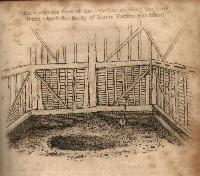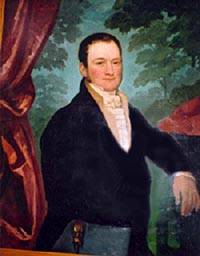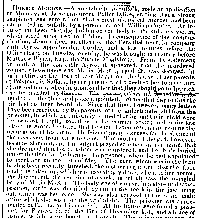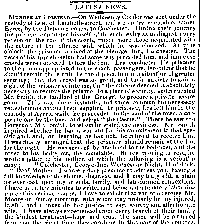 |
 |
 |
Several months went by and the Marten family had no word from Maria. They could not understand how she could leave her son for so long. Corder's explanations were vague, unsatisfactory or improbable. He told them she was well; that she was staying with a Miss Rowland in Yarmouth. On October 18th 1827 he wrote in a letter to Thomas Marten from London (reproduced in Curtis, p.154) that they were man and wife. He told the family that Maria was staying in Newport, Isle of Wight, and expressed surprise that they had not answered Maria's letter describing the marriage. Trying to cover his tracks, he suggests in a post-script that Mr Marten take down the address for a reply and then burn the letters. In letters to Peter Matthews (the father of Maria's son) he wrote that she had hurt her hand and could not write. Her family felt increasingly alarmed.
Maria's stepmother at last asked her husband to search the Red Barn. She said that she had often dreamed about Maria. Twice, (once before and once after Christmas) she had dreamed that Maria was murdered and buried in the Red Barn. She had not wanted to tell her husband because he would have thought her superstitious. For some time he did nothing, but at last gave in to her nagging. With a friend he went to the barn. Prodding the floor with his mole-spud, he found a soft spot. He dug out some eighteen inches (50cm) of loose earth and discovered a body stuffed into a sack. A green silk handerchief showed through. Mr Marten recognised it as one belonging to Corder which Maria had been wearing when she left the house. They left the body where it lay and called in the constabulary.
|
 |
John Wayman the Coroner at Bury St Edmunds was sent for. Although it was a Sunday, he summoned a jury, viewed the body, and held an inquest at the Cock Inn in Polstead. Maria's sister Ann recognised the body from a missing tooth, the hair, her clothing and belongings. Other evidence was given which implicated William Corder. The local constable, Ayres, knew that his brother-in-law was a friend of Corder. From him he got a contact address in London. From that starting point, Ayres and a London policeman, Constable Lea, traced Corder through a number of addresses until they found him at home in Ealing Road, Brentford. He was in his dressing gown, timing eggs for breakfast. The arrest was reported in the"Times" of April 24th 1828. Two articles in John Bull Magazine for Sunday April 27th 1828 give a fuller account of the arrest.
From "The Times", April 24th 1828
On Tuesday night, William Corder was brought before MATTHEW WYATT, Esq., at the Lambeth-street police-office, in
custody of Lea, the officer, charged with the perpetration of the
murder, the particulars of which were stated in our paper of
yesterday.
|
 |
From "John Bull Magazine, Sunday April 27th 1828. HORRID MURDER.- A constable from Suffolk, made an application on Monday, at Lambeth-street Police Office, stating that a strong suspicion was entertained that a most diabolical murder had been committed in Suffolk, by a person named William Corder. An inquest had been that day holden on the body of the unhappy victim, which stood adjourned to Friday. In consequence of this communication, James Lee, an officer of that Establishment, in company with Ayres, apprehended Corder, and a few minutes before the Office closed on Tuesday evening, he was brought in custody before Matthew Wyatt, Esq., the Sitting Magistrate. From the statement on oath of the constable Ayres, it appeared, that the murdered woman, whose name was Maria Martin, aged 26, was decoyed, in male attire, on the 18th of last May, from the house of her parents at Polstead, in Suffolk, by the prisoner, who desired her to meet him at his red barn, when he promised her that they should go to Ipswich and be married by licence. The unsuspecting girl accordingly attended at the time and place appointed. From that day to this the girl had not been heard of. Since that time, however, many letters have been received by the parents of the unfortunate girl from the prisoner, in which he uniformly stated that he and their child were living most happily together in the married state; and in the last letter he wrote, he stated that he should soon return and resume the occupation of his farm. He feigned many excuses for the silence of the deceased, from time to time. The mother of the girl, however, became alarmed, and the subject preyed so much on her mind, that she dreamed that her daughter was murdered, and her body buried under the floor in the barn of the prisoner, where he had appointed to meet her on the 18th of May. The corn which was in the barn having been recently threshed, the mother requested that the floor might be taken up, which was accordingly done, when, to her horror she discovered, the remains of a sack, in which was the mangled body of Maria Martin ! The body was of course, in a state of decomposition, but it was identified by one of the teeth in the jaw being out, which was her case. She was also dressed in the same male attire which she wore on the fatal night. The prisoner was apprehended at Ealing, and is married. At his house were found a passport for France, dated the 17th of December last, and a brace of pistols, which were bought at Ipswich. The prisoner appears to leave been impelled to the frightful act by fear of the discovery of some former offence. He was on Wednesday brought up to Lambeth-street for a short examination, prior to his transmission to Suffolk, His age was stated to be twenty-four. His complexion is florid; but during the time he was at the bar it varied considerably. His dress was fashionable and when taken into custody, he, in conjunction with his wife, kept a boarding-school for females, at the Grove-house, Ealing-lane, Middlesex. Information of the murder, was communicated to W. Wayman, Esq., the coroner of Bury St. Edmund's. He instituted an inquiry, and from the circumstances that came out on it, he was induced to despatch Ayres, a constable in pursuit of the prisoner. He arrived in town on Monday, and having applied at the above office for assistance, the business was placed in the hands of Lea. With a loose clue afforded him by the Country constable, he traced the prisoner first to Grays-inn-terrace, and from thence through a number of intermediate places to his residence, in Ealing-lane, near Brentford, where he apprehended him. A degree of stratagem was necessary to obtain an entrance, and he procured it by representing that he had a daughter whom he was anxious to place under the care of his wife. On going in, he found him in the parlour with four ladies, at breakfast. He was in his dressing gown, and had a watch before him by which he was minuting the boiling of some eggs. Lea called him on one side and told him that he was a London police-officer, and had to apprehend him on a most serious charge. He seemed somewhat alarmed, and at his request they retired in to the drawing-room, but on his being made acquainted with the nature of the offence, he denied all knowledge of it, as also of his unfortunate victim. Lea, after having secured him, proceeded to search both his person and drawers, and discovered a number of letters from a person named Gardner, in which warnings were held out, and cautions given of a singular description. He also found a case of detonating pocket pistols, maker's name "Harcourt, Ipswich" supposed to have been purchased on the day of the murder, together with a powder-flask, and a quantity of balls. It appears from a document found in his possession, he purposed leaving this country for the Continent, as he was provided with a passport, dated the 20th of December, l827, from the French Ambassador. Previous to his removal to town, his brother-in-law, a most respectable man (whose name, not wishing to wound his feelings, we forbear mentioning), having ascertained the serious offence with which he was accused, questioned his sister as to time length of time she had known the prisoner before she had married him. She answered, only for three weeks, and that she first became acquainted with him through the medium of a matrimonial advertisement, at a pastrycook's shop in Fleet-street, to which he had given a reference. She married him at the church of St. Andrew, Holborn, in November last, and was quite unaware of his being guilty of any offence. At three o'clock, the prisoner, in the keeping of Lea, was transmitted to the county gaol of Suffolk. His wife, whose impression that the charge against him is that of bigamy, was with him in the lock-up room during the greater part of the forenoon. From "John Bull", April 27 1828
|
 |
LATEST NEWS. MURDER AT POLSTEAD."On Wednesday Corder was sent under the custody of Lea, of Lambeth-street, and a country constable, named Eyres, by the Defiance coach, to Colchester. During their journey the prisoner conducted himself with such levity as to disgust every person on the roof of the coach, much more those acquainted with the nature of the offence with which he was charged. At nine o'clock the prisoner arrived at the George Inn, Colchester. The news of his apprehension had some way preceded him and immense crowds were collected before the inn. Lea conducted his prisoner to the room appropriated to the coach passengers, intending that he should remain there until he could place him in a situation of greater security ; but the crowd was so great, and their anxiety to gain a sight of the prisoner so intense, that the officers deemed it absolutely necessary to remove the prisoner to a place of security, and requested Mr. Smith, the landlord of the George, to procure a private secure room. This was done instantly, and some common but necessary refreshments having been supplied the prisoner, Lea left him in the custody of Ayres, while he proceeded to the gaol of the town, a corporate one by the bye, and yclept "the Castle." There he saw the Governor, Mr. Smith, to whom he stated the business. Mr. Smith inquired whether he had a warrant for his commitment to that specific gaol, and, on learning he had not, he refused to receive him. It was finally arranged that the prisoner should remain at the Inn for the night. He was secured by one hand to the bed-post, and the other to his bedfellow, the constable. Before retiring to rest, he wrote a letter to his mother, of which the following is a verbatim copy ; " Colchester, George-Inn, Wednesday Night. 11 o'clock.
"Dear Mother"I scarcely dare presume to address you, having a full knowledge of the shame, disgrace, and I may truly add, a stain for ever cast upon my friends, family, and late-formed connexions. I have but a few minutes to write, and being unfortunately labouring under this serious charge, I have to solicit that you will receive Mr. Moore on Friday morning, with whom may probably be my injured, lawful, and I must do her justice to say, worthy and affectionate wife. I have always experienced from every branch of their family the kindest treatment - hope and trust the same will be returned from you the short time they continue in this part of the country, which I am sorry to have to state is to hear the event of this dreadful catastrophe. I am happy to hear you are tolerably well, considering the circumstances. I may, perhaps, be allowed an interview with you in a day or two, but that is very uncertain. Must beg to subscribe myself your affectionate son, "W. Corder." The Jury have returned a verdict of Wilful Murder against the prisoner.
The unhappy young man is only twenty-four years old. He was brought in to the room to hear the depositions read, and was in so melancholy a state of bodily and mental prostration, as to appear wholly unconscious of what was going on. From "John Bull" April 27th 1828 NB: Note the two spellings, "Eyres" and "Ayres"
|
| Go to Red Barn Homepage | Go to next topic - The trial |
Created 23 July 2001 by St Edmundsbury Museums Staff Last updated 27 December 2006 | Go to Main Home Page |